

A Periodic Table of Instructional Design.
How To Brain Sync With A Subject Matter Expert. SumoMe Short of performing a science fiction mind-meld, how can you efficiently transfer content from the brain of a subject matter expert (SME) into a form you can use?
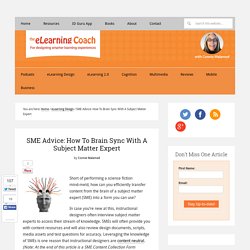
In case you’re new at this, instructional designers often interview subject matter experts to access their stream of knowledge. SMEs will often provide you with content resources and will also review design documents, scripts, media assets and test questions for accuracy. Leveraging the knowledge of SMEs is one reason that instructional designers are content neutral. (Note: At the end of this article is a SME Content Collection Form designed by Abigail Wheeler.) 15+ eLearning Storyboard Templates. Posted: 05.09.2012 | Author: Nicole L. | Filed under: eLearning, Instructional Design | Tags: eLearning, Instructional design, Storyboard, Templates |22 Comments If you have to create a storyboard for an e-learning course you’re working on, odds are you’ve come to the web to browse around and get ideas on what you want to include in it.
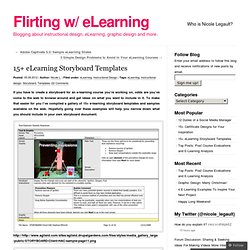
To make that easier for you I’ve compiled a gallery of 15+ e-learning storyboard templates and samples available on the web. Hopefully going over these examples will help you narrow down what you should include in your own storyboard document. Got any tips of your own about storyboarding for e-learning? What's your favorite question to ask during an SME interview? Hey these are great.
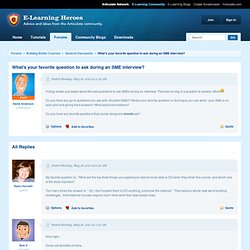
Thanks! I'll share the link and hopefully some more folks will update. @Rainy - The million dollar question, right? Design. Design brings forth what does not come naturally.
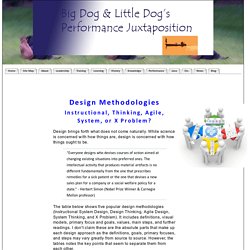
While science is concerned with how things are, design is concerned with how things ought to be. “Everyone designs who devises courses of action aimed at changing existing situations into preferred ones. The intellectual activity that produces material artifacts is no different fundamentally from the one that prescribes remedies for a sick patient or the one that devises a new sales plan for a company or a social welfare policy for a state.” - Herbert Simon (Nobel Prize Winner & Carnegie Mellon professor) The table below shows five popular design methodologies (Instructional System Design, Design Thinking, Agile Design, System Thinking, and X Problem). It includes definitions, visual models, primary focus and goals, values, main steps, and further readings.
Instructional Design Basics: Designing A Timeline. PowerPoint Presentation Development. A Place for Ideas and Inspiration. Beginning Instructional Authoring: Getting the Content You Need from SMEs, Part 1 by Patti Shank. “Many eLearning designers and developers will say that it’s impossible to train SMEs to use the same tools that we use but I think that’s a ridiculous notion.

Rapid development tools were made for SMEs to use. Many of us use PowerPoint as our initial development tool and many SMEs can use PowerPoint. And let’s face it, many trainers and instructional designers were once SMEs.” It’s an inside joke in the eLearning world. Getting content from your subject matter experts (SMEs) can be a bit of a nightmare.
This situation is a common one and it’s a problem that has an obvious solution: Be much more specific about exactly what you need. Getting specific Here’s an example from real life. Table 1. The main idea here is to give SMEs more direction in the content that you want them to provide so that both you and the SME are less frustrated. Text content templates There are two common ways that we ask SMEs for content and both have typical flaws. Figure 1. Figure 2. Instructional Design Models. Instructional Design Models Models, like myths and metaphors, help us to make sense of our world.
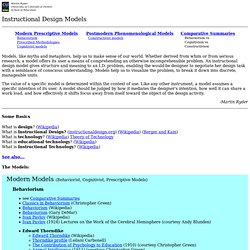
Whether derived from whim or from serious research, a model offers its user a means of comprehending an otherwise incomprehensible problem. An instructional design model gives structure and meaning to an I.D. problem, enabling the would-be designer to negotiate her design task with a semblance of conscious understanding. Models help us to visualize the problem, to break it down into discrete, manageable units. The value of a specific model is determined within the context of use. -Martin Ryder Some Basics. Instructional Design and eLearning: Tips, Advice and Reviews. 6 Thinking Hats & Instructional Design. Top Resources for Instructional Designers. E-learning quality assurance standards, organizations and research. I am surprised how often academic colleagues argue that there are no quality standards for e-learning. Well, hello, I’m sorry, but there are and some of them are damned good.
Learning, Instructional Design & Training. Fundamental Design of Learning Activities. I’ve quoted Richard Buchanan previously in a definition of Design Thinking as “the integration of signs, things, actions and environments that addresses the concrete needs and values of people in diverse circumstances.”
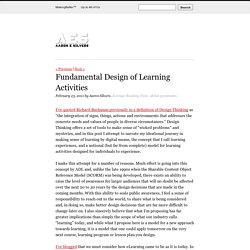
Design Thinking offers a set of tools to make sense of “wicked problems” and mysteries, and in this post I attempt to narrate my ideational journey in making sense of learning by digital means, the concept that I call learning experiences, and a notional (but far from complete) model for learning activities designed for individuals to experience. I make this attempt for a number of reasons. Much effort is going into this concept by ADL and, unlike the late 1990s when the Sharable Content Object Reference Model (SCORM) was being developed, there exists an ability to raise the level of awareness for larger audiences that will no doubt be affected over the next 20 to 30 years by the design decisions that are made in the coming months. Custom E-Learning Training & LMS Solutions Kineo. 10 Tips to Help You Get Started. I get lots of questions from those who are just getting started with rapid elearning.
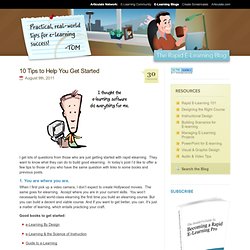
They want to know what they can do to build good elearning. In today’s post I’d like to offer a few tips to those of you who have the same question with links to some books and previous posts. 1. You are where you are. When I first pick up a video camera, I don’t expect to create Hollywood movies. ITForumReevesJan08.doc - Powered by Google Docs. How To Brain Sync With A Subject Matter Expert: The Learning Coach. E-learning Principles: Five Free, Downloadable Resources. Creative Instructional Designer for Elearning: Cathy Moore. Technology Integration Matrix. Top Resources for Instructional Designers.
Instructional Technology. There are two views for the definition of technology. Traditionalists view it as the systematic application of science to practical problems. A more contemporary view is that technology is the application of knowledge so that it can be built from one generation to the next (Braudel in Seels & Richey, p. 7). The second view is not synonymous with integration, although it certainly does have implications for integration, but in a systematic way. As such, technology includes tools, processes, applications, skills and organization. Technology in education or instruction is more than the technical application of tools, machines, computers, products and communication systems (such as multimedia, computerized instruction, games, simulations or interactive video). 22 Books For Beginner Instructional Designers. Digitallearningnow.